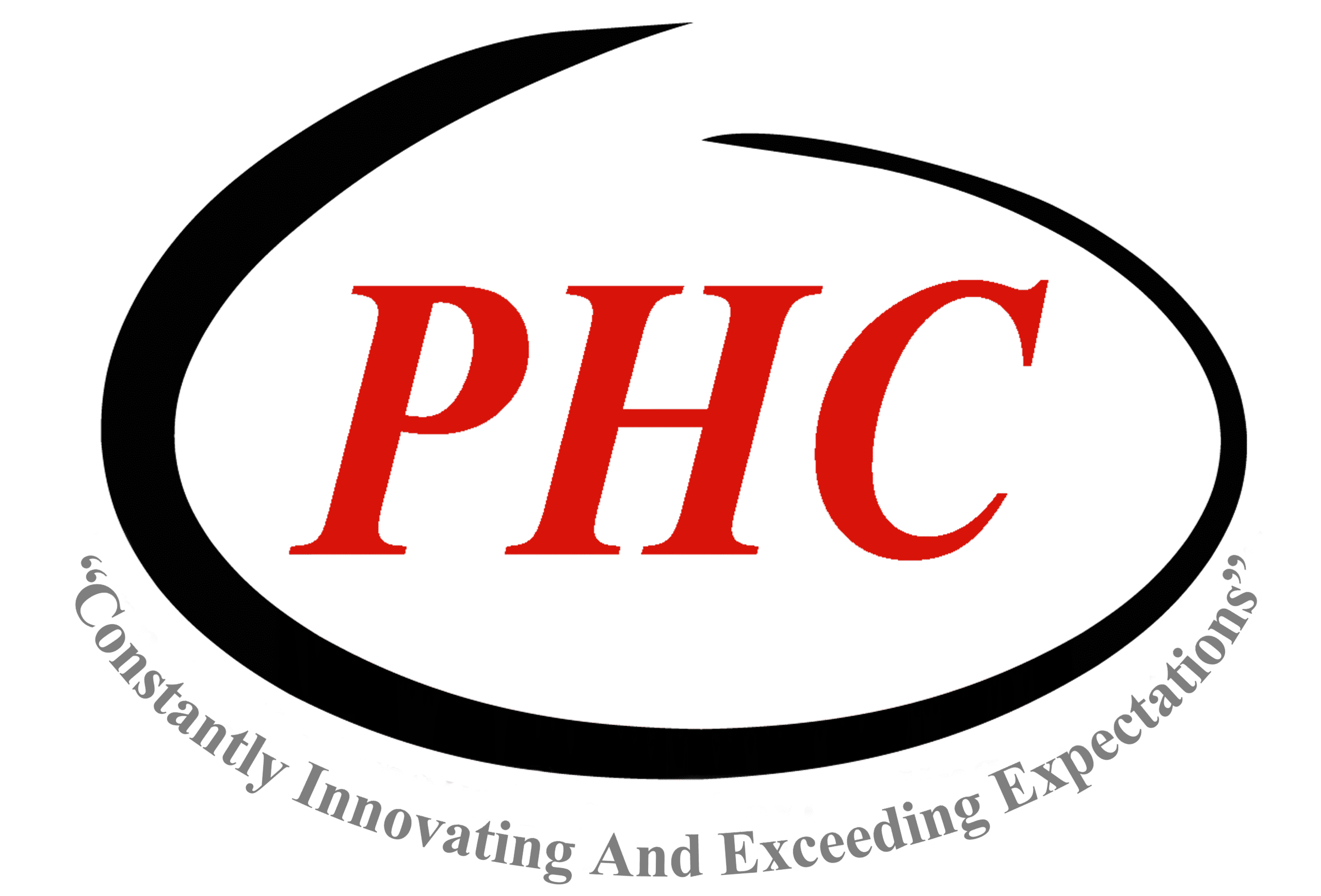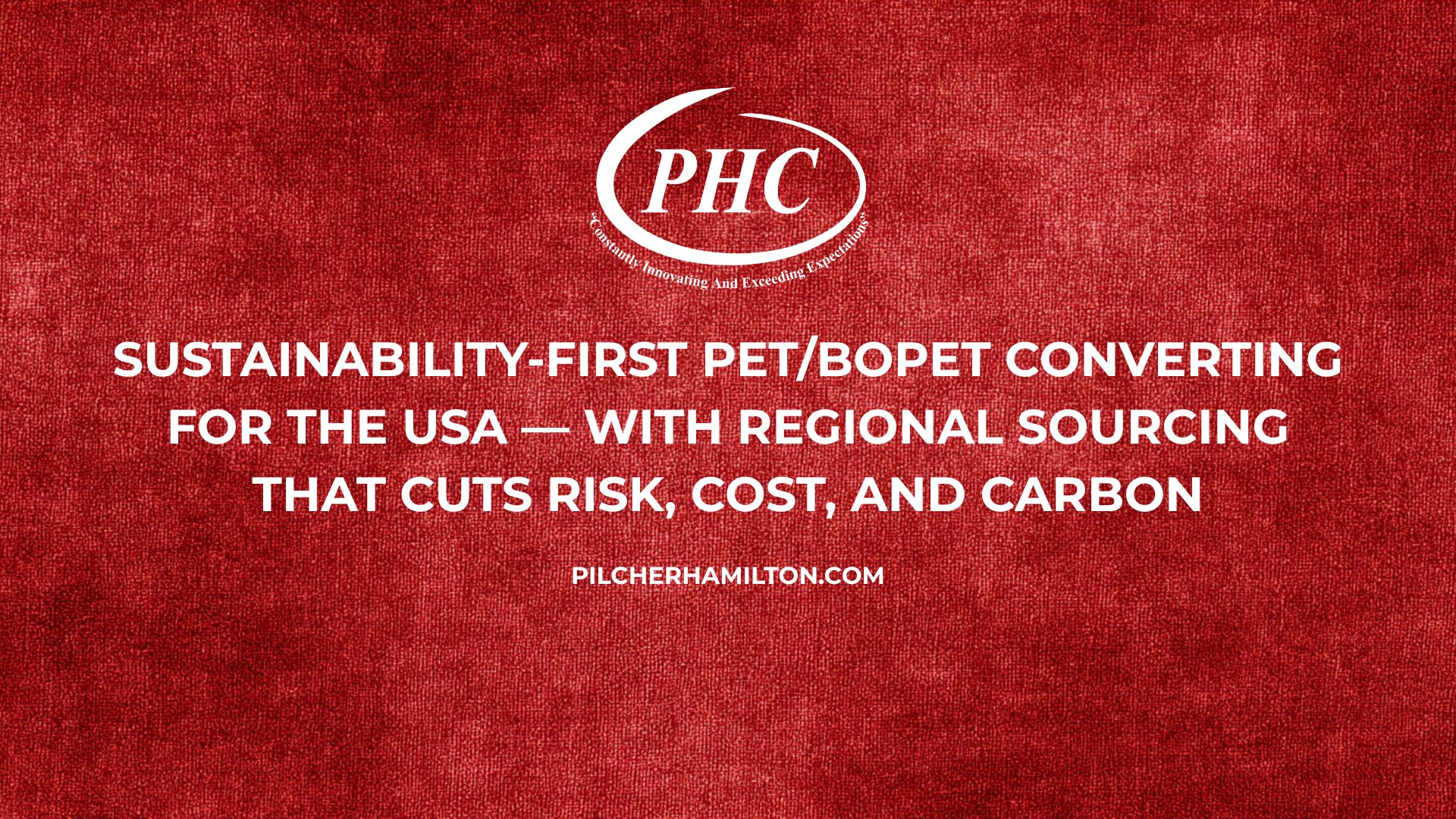Bottom line for engineers and buyers: Pilcher Hamilton Corporation (PHC) is a merchant supplier and converter of polyester films—not a base‑film manufacturer. We source high‑quality PET/BOPET from U.S. primary producers and add value in our Greer, South Carolina hub via slitting, coating, corona treatment, sheeting, winding, and toll converting. Our sustainability approach starts with smart regional sourcing (shorter lanes, fewer touches), and continues with PCR content (up to 90%), closed‑loop waste reduction, and design‑for‑recycling structures that still hit performance targets—gauge 8–200 µm, dyne 38–52, COF 0.2–0.6, seal windows 200–400 °F, and barrier options down to OTR <1 cc/m²/day; WVTR <1 g/m²/day.
1) What “sustainability” means in practice for PET films
Regionalized supply
- PHC’s Greer, SC converting hub sits in the densest U.S. polyester ecosystem, near Mitsubishi Polyester Film (Greer)—allowing rapid A/B trials and short replenishment loops. Mitsubishi’s REPROCESS™ program is a well‑documented closed‑loop initiative for spent PET release liners that are reprocessed into first‑quality release liners with up to ~25% post‑industrial recycled (PIR) content—an example of the kind of regional, circular flows PHC can plug into through our SC hub.
PCR, not just PIR
- We support post‑consumer recycled (PCR) PET films—including printable and metallizable grades—so you can reduce Scope‑3 footprint without compromising line performance. PHC’s PCR program highlights lower carbon footprint vs. virgin PET and diversion from landfill; we convert these materials to your dyne/COF/seal targets. Learn more on PHC’s Sustainability First (USA) overview and PCR PET product page. (Pilcher Hamilton Corporation)
Designing for recyclability
- For flexible packaging, recyclability hinges on structure choices and guidance from APR (Association of Plastic Recyclers). When the target is PE‑flexible store drop‑off acceptance, APR’s guides favor mono‑PE designs (e.g., PE/PE, BOPE or MDO‑PE) with carefully selected coatings/inks. PHC will help you evaluate when to stay with PET for performance (e.g., stiffness, heat resistance, print clarity) and when to pivot to PE‑forward laminates or to detachable/barrier‑label approaches that preserve end‑of‑life options. See APR’s Design Guide overview and PE‑flexible section for baseline rules.
2) Regional sourcing with a sustainability lens: SC and AL focus
- South Carolina (SC): As the U.S. epicenter for polyester film operations, SC enables short, resilient supply chains. Mitsubishi Polyester Film’s REPROCESS™ liner program demonstrates a functioning regional loop for PET release liners—ideal when your portfolio includes self‑adhesive labels or protective liners that can be recovered and remanufactured locally. PHC coordinates collection logistics (where available), spec confirmation, and converted‑to‑order widths/roll builds for fast re‑deployment into PSA and graphics workflows.
- Alabama (AL): Polyplex USA (Decatur) has publicly emphasized sustainability and capacity additions, including a major U.S. PET film expansion (circa 2024–2025). As a U.S. producer with published sustainability goals (including rPET product families), Polyplex supports domestic supply resilience—reducing trans‑oceanic lead times and emissions. PHC leverages such U.S. sources to maintain performance, price, and sustainability balance in your specs.
- Broader Northeast supply: Toray Plastics (America), RI complements the U.S. PET ecosystem and publishes multiple circularity initiatives (including Ecouse™ Lumirror™, a circular PET film line that accepts coatings and vapor deposition). PHC routinely converts Lumirror grades and will align your dyne/COF/seal targets with Toray’s sustainability options.
Why this matters: every extra 500–1,000 miles of transport and every import queue injects risk, cost, and carbon. Tight SC‑AL‑RI corridors and PHC’s Greer hub mean fewer touches, more predictable lead times, and easier closed‑loop opportunities on trims and spent liners.
3) Engineer‑ready technical ranges (what we dial in for you)
- Gauge (thickness): 8–200 µm (≈0.32–7.87 mil). Common stock points: 12, 23, 36, 48, 50, 75, 100, 125, 190 µm.
- Surface energy (dyne): 38–52 dyn/cm, via corona or chemical treatment, side‑specific or dual‑treated. [PHC corona‑treated program.]
- COF (film/film): 0.2–0.6; 0.2–0.4 typical on silicone release faces; 0.3–0.5 is a practical “machineability” zone for HFFS/VFFS.
- Barrier options:
- Metallized PET (Al 20–40 nm): OTR <1 cc/m²/day; WVTR <1 g/m²/day at 23 °C (typical), ideal for aroma/oxygen protection in snacks/coffee.
- PVDC‑coated PET: typical OTR 5–10 cc/m²/day and improved moisture barrier with clear view of product.
- Metallized PET (Al 20–40 nm): OTR <1 cc/m²/day; WVTR <1 g/m²/day at 23 °C (typical), ideal for aroma/oxygen protection in snacks/coffee.
- Seal windows: 200–400 °F (93–204 °C) overall; 250–350 °F typical for peelable lidding to APET/CPET/PP; we’ll match peel force (N/15 mm) to your tray/film partner.
- Electrical insulation: Dielectric >3 kV/mil; UL‑recognized grades with tight camber for slot liners/coils.
- PCR content: up to 90% (select grades), printable/metallizable, typical dyne 38–44 for ink/adhesive anchorage. See PHC PCR and Sustainability First pages for FAQs and options. (Pilcher Hamilton Corporation)
Note: Barrier, seal, and slip performance depend on total construction (primer, slip system, barrier layer, treatment) and your line (jaw profile, dwell, pressure, nip/rewind tension). We’ll tune dyne/COF/seal to your tooling and run speeds.
4) Sustainable structures that still hit performance numbers
A) Transparent barrier where recyclability is important
- PVDC‑PET12 // PE60: Achieves OTR ~5–10 with product visibility. If moving toward mono‑PE, consider PET‑as‑print/rigidity layer in a detachable or label‑forward system; otherwise use BOPE/PE per APR guidance. PHC can deliver PET clarity (haze <1%) and dyne ≥42 for aggressive ink sets, or pivot you to a mono‑PE platform when end‑of‑life trumps PET stiffness.
B) High‑barrier with shelf‑life priority
- mPET12 (OTR <1; WVTR <1) laminated to PE or CPP provides oxygen and aroma barrier for coffee/snacks/dry dairy. If you need PCR, metallize PCR‑capable PET grades (subject to base quality and dyne retention). PHC will confirm metal adhesion and seal curves on your line.
C) Lidding to APET/CPET with clean peel
- Heat‑sealable PET 12–36 µm, peelable; COF 0.3–0.5 for machineability; seal 250–330 °F with controlled peel force. We’ll specify which side is seal vs print and target dyne ≥42 on the print side.
D) PSA liners and composite release (closed‑loop opportunity)
- Silicone‑coated PET 23–75 µm; target COF 0.2–0.4 and specified release force window (low/med/high). Where feasible, coordinate spent‑liner recovery into the REPROCESS™ stream; PHC can support slit patterns and defect‑mapped winding to maximize reclaim.
E) UL electrical / industrial
- Industrial PET 50–190 µm; dielectric >3 kV/mil; slit ±0.005″; printable backside if labels/marking are needed. PCR can be used in some non‑critical covers/spacers—PHC will review dielectric impacts grade‑by‑grade.
5) How PHC reduces your footprint beyond materials
(1) Shorter logistics (regional base webs):
- Pair SC (Mitsubishi Greer) and AL (Polyplex Decatur) base webs with PHC Greer converting to cut miles, time, and variability. Polyplex’s expansion and sustainability focus underscore the resilience of U.S. PET capacity you can rely on.
(2) Roll‑to‑roll coatings instead of complex multi‑laminates:
- Apply 0.5–5 µm of acrylic, anti‑fog, anti‑static, or PVDC to meet performance targets without over‑building structures—often fewer layers = simpler end‑of‑life. [PHC coating services.]
(3) Tight converting tolerances = less scrap:
- Slitting: ±0.005″, 1–60″ widths; defect/splice rules agreed ahead—lower trim loss at your plant.
- Sheeting: ±0.010″ to 60″ × 100″.
- Winding: Tension‑controlled; camber managed; bar‑code & lot traceability.
- Toll converting: Process your supplied webs with our SOPs to minimize waste, shorten lead‑time, and keep your sustainability ledger clean.
(4) Closed‑loop trim and liner programs:
- Where your operation generates recoverable PET side‑trim or spent liners, PHC helps evaluate return‑to‑producer options (e.g., liners into REPROCESS™) and integrate those back into first‑quality liner film.
6) Spec inputs to capture in your RFQ (so we nail it on Lot 1)
- End use & structure: e.g., mPET12//PE70 with OTR <1, WVTR <1; or PVDC‑PET12 for clear oxygen barrier.
- Gauge: 8–200 µm (tolerance and caliper method).
- Surfaces: side A/B dyne (38–52), corona vs chemical, primer or functional coats.
- COF: static/kinetic targets (0.2–0.6), film/film vs film/steel; any release force window (if silicone).
- Seal: partner (APET/CPET/PP/PE), initiation and window (200–400 °F), peel vs weld, peel force (N/15 mm); jaw dwell/pressure profile.
- Barrier verification: OTR/WVTR method & set points; aroma/caffeine/oxygen sensitivity if relevant.
- Optics: haze %, gloss GU; or opacity 85–95% (if white).
- Electrical: dielectric (kV), UL grade/thermal class.
- Roll build: slit widths ±0.005″, OD/length, core (3″/6″), splice policy, defect mapping.
- Sustainability flags: PCR %, reclaim/liner return options, APR target pathway (e.g., PE‑flex).
7) Where U.S. producers’ sustainability work meets your spec
- Mitsubishi Polyester Film (Greer, SC) — REPROCESS™: Collects spent PET release liners and reprocesses them into first‑quality liners with up to ~25% PIR content; a practical closed‑loop that PHC can integrate into liner‑heavy programs.
- Polyplex USA (Decatur, AL) — rPET/Sustainability focus: Corporate programs and U.S. capacity expansion support regionalized PCR/rPET availability and robust domestic supply.
- Toray Plastics (America), RI — Ecouse™ Lumirror™ circular PET film line; Toray’s U.S. operations publish sustainability targets and product pathways that accept coatings and vacuum deposition.
- PHC’s role: We don’t make base film; we convert and customize—bringing these regional materials under one roof in Greer, SC to deliver dyne 38–52, COF 0.2–0.6, seal 200–400 °F, and validated barrier/optical performance for your line, often from stock (>10,000,000 lb) for 24–48 h shipment.
8) Quick picks (sustainability‑leaning) you can trial immediately
- Transparent oxygen barrier, see‑through pack: PVDC‑PET12 (OTR 5–10) // PE60; dyne ≥42 on print face; mono‑PE variant available if APR‑PE path is the priority.
- High barrier for coffee/snacks: mPET12 (OTR <1, WVTR <1) // PE70; PCR‑capable base webs on request; confirm metal adhesion after print/lam.
- Peelable lidding to APET/CPET: Heat‑sealable PET 12–36 µm; seals 250–330 °F; COF tuned 0.3–0.5; peel force tailored to line.
- PSA & composites: Silicone‑coated PET 23–75 µm; COF 0.2–0.4; differential release; consider REPROCESS™ return for spent liners.
- Sustainable graphics/labels: PCR PET (30–90% PCR) with dyne 38–44; acrylic topcoat for ink adhesion; metallizable option for barrier/appearance. (Pilcher Hamilton Corporation)
9) Practical conversions & test notes
- 1 mil = 25.4 µm. (12 µm ≈ 0.47 mil; 23 µm ≈ 0.91 mil; 50 µm ≈ 1.97 mil; 100 µm ≈ 3.94 mil; 200 µm ≈ 7.87 mil.)
- State barrier test method and conditions (e.g., ASTM D3985 at 23 °C, 0% RH for OTR; ASTM F1249 for WVTR), as small changes in RH/temperature can shift values.
- Capture jaw temperature/dwell/pressure, nip/rewind tension, and line speed in the trial protocol—these drive seal and slip outcomes as much as film recipe.
10) Why PHC is the low‑risk path to sustainable PET/BOPET specs
- We are converters with the widest U.S. base‑web access—we’ll choose the right SC/AL/RI source and spec the converting that meets your tape‑and‑tolerance reality.
- We stock >10,000,000 lb of film for 24–48 h shipment on common gauges, dyne levels, and slip/barrier configurations.
- We design for end‑of‑life using APR guidance and regional closed‑loop options (e.g., spent liner recovery) without giving up the stiffness, heat resistance, and clarity that PET does better than anything else.
Ready to spec?
Send your RFQ with: gauge (8–200 µm), dyne (38–52), COF (0.2–0.6), barrier targets (e.g., OTR <1; WVTR <1), seal window (200–400 °F), roll build (±0.005″), and any PCR % or closed‑loop requirements. We’ll return two or three ready‑to‑run structures geared to your line and your sustainability goals.
Deep‑dive PHC links:
- Learn more about PCR PET options: Post‑Consumer Recycled PET films. (Pilcher Hamilton Corporation)
- Explore PHC’s latest sustainability guidance: Sustainability First (USA) — PET films & green converting. (Pilcher Hamilton Corporation)
Value‑added services: Slitting, Coating, Corona‑treated, Toll converting.

